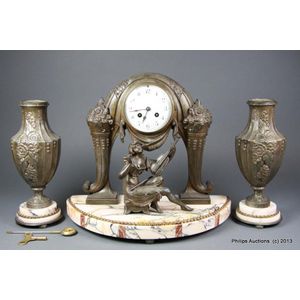French Gilt Metal and Marble Mantel Clock and Vase Garniture
You must be a subscriber, and be logged in to view price and dealer details.
Subscribe Now to view actual auction price for this item
When you subscribe, you have the option of setting the currency in which to display prices to $Au, $US, $NZ or Stg.
- Pendulum - The pendulum was discovered around 1602 by Galileo Galilei, and was adopted for time keeping by the Dutch mathematician and natural philosopher, Christiaan Huygens, who excelled in astronomy, physics, and horology.
The pendulum comprises a metal rod usually of brass or steel with a metal disk, known as a bob, at the end. The movement of the pendulum is driven by weights or a spring, and as a pendulum swings in a regular arc, it was found accuracy could be controlled to within a few seconds a week.
Timekeeping can be adjusted by changing the height of the bob on the rod, making the pendulum either swing slower or faster.
The disadvantage of the pendulum was that changes in temperature also changed the length of the pendulum, interfering with the accuracy of the clock, and so in the 18th century two types of mercurial pendulums were invented which countered the movement in the steel rod.
The pendulum was the world's most accurate timekeeping technology until the invention of the quartz clock, regulated by a quartz crystal, in 1927. - Incised - A record of a name, date or inscription, or a decoration scratched into a surface, usually of a glass or ceramic item with a blunt instrument to make a coarse indentation. Compare with engraving where the surface is cut with a sharp instrument such as a metal needle or rotating tool to achieve a fine indentation.
- Movement - The technical name for the workings of a clock or watch, and does not include the dial or case.
This item has been included into following indexes:
Visually similar items

A neoclassical gilt bronze and marble clock garniture, circa 1880/90; with the dial marked Caron, the painted enamel dial with Roman numerals set within a gilt bronze drum head raised on a swagged and shaped plinth base, flanked by a seated bucolic maiden,

Large pair of Sevres style vases, 8 cm high (2)

An Art Nouveau marble and spelter clock garniture, circa 1900; movement by Marti. Upon an apricot flecked demi-lune marble base with two cornucopia spilling flowers and supporting a draped arch and an enamel dial with Roman numerals, to the fore a seated f

Pair of impressive large Royal Crown Derby vases, handpainted birds in reserve, on dark blue ground. Signed H Harris, 40 cm high
